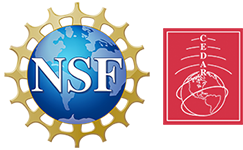2025 Workshop: MPEC
Early-career conveners: Kat Davidson
The particles precipitating from the magnetosphere play an important role in the determination and modelling of ionospheric electrodynamics, especially conductance which modulates the magnetosphere’s response to the solar wind. Precipitation of magnetospheric particles and their energy deposition in the Earth’s upper atmosphere depend on a number of parameters including, but not limited to, their magnetospheric origin, energy range, flux, auroral display, spatiotemporal scale, etc. As a result, the ionospheric conductance can be modified in various ways further affecting the plasma convection, field-aligned (FAC) and ionospheric currents, and ionospheric/thermospheric temperature and densities. Therefore, understanding the properties of different sources of magnetospheric precipitation and their relative roles in the electrodynamic coupling of M-I across a broad range of spatiotemporal scales is crucial for improving predictive modelling capabilities. The 2024 Decadal Survey theme on “Sun-Earth-Space: Our Interconnected Home” identifies magnetospheric precipitation a critically important phenomenon for the transition region in the guiding question “How Do Heliosystem Boundaries Manifest Themselves?”. Furthermore, characterization of the magnetospheric precipitation is one of the basic research needs identified in the decadal survey for specific operational and scientific capabilities. This broad topic necessitates advancing the physical knowledge and improving the numerical modelling of:
- The magnetospheric particle precipitation (precipitation mechanism and characteristics, magnetospheric origin, auroral forms).
- The effects of particle precipitation on the ionospheric electrodynamics, with an emphasis on the ionospheric conductance.
- Response of the I-T system to precipitation and its feedback to the Magnetosphere.
We invite presenters to share their research on new investigations that advance our understanding and predictive capabilities of magnetospheric precipitation and physical phenomena related to the coupling of MIT systems.
1. Sam Walton, Energetic Electron Transport in the Inner Radiation Belt as a Source of Low-Latitude Precipitation
2. Dedong Wang, TBD 3. Kalpesh Ghag, Investigations on the role of EUV and precipitation in interhemispheric asymmetries using MAGE simulations
4. Shan Wang, Correlated Discontinuous Energetic Electron Precipitations and aurora arcs in the polar cap
5. Prakash Poudel, Effects of Auroral Precipitation and Electric Fields on Ionosphere Thermosphere Response to the 2023 March Storm Using PFISR, GOLD, GNSS and Data Assimilated TIEGCM
6. Louis Ozeke, Investigating Energetic Particle Precipitation and Atmospheric Climate Impacts with the Canadian RADICALS Mission
7. Shipra Sinha, Anomalous Substorm Signatures During Sudden Solar-Wind Pressure Enhancements
8. Lily Daneshmand, ULF Wave Modulation of Lower-Band Chorus During Pulsating Aurora Events
9. Shannon Hill, Investigations on Theta Aurora using SWMF simulations
As the MPEC focus group, we request two stand-alone sessions in the CEDAR-GEM Workshop. One session will be dedicated for researchers to discuss advances in understanding precipitation sources and effects in the coupled MIT system. The second session will be a community discussion evaluating our fourth year goals and determining the next steps for the MPEC FG with the community. These sessions are expected routine activities of the selected FG in GEM.
"Magnetospheric Sources of Particle Precipitation and Their Role on Electrodynamic Coupling of Magnetosphere-Ionosphere-Thermosphere Systems", Dogacan Ozturk
